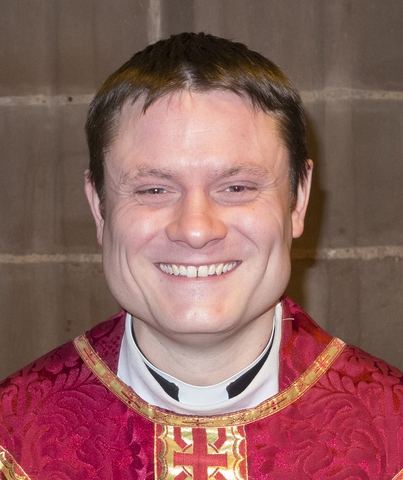
From the Clergy for September
18 Aug 2021 • From the Clergy
Coventry Cathedral is a striking building in many ways, but one of its most memorable features is the large, bronze sculpture of Michael defeating the devil on its east wall. The work of Jacob Epstein in 1958, it is a vivid reminder of the cathedral’s dedication to St Michael, but it is a popular theme around the Christian world. A stone’s throw from the Anglican Cathedral in Miraflores, Lima, Michael presides over a roundabout from atop a column.
On tiny Eriskay in the Outer Hebrides, Michael guards the gate into a fascinating little church where the altar surmounts an upturned boat. This is just a trio of examples I have seen; there are thousands of others around the world. While the church ones often represent the dedication, they also form a reminder with the others of Michael’s place in Christian thought as a divine protector. Confusingly, Michael is widely referred to as St Michael (as is the case in our church with that dedication). Quite why this is so unclear. It may be a desire to show particular honour to him, or it may result from some confusion over the Latin word ‘sanctus’, which means ‘holy’. Whatever the case may be, he is actually an angel, or, if we are being pedantic, an archangel (see Jude 1:9). The complexities of angelic hierarchies needs an advanced degree to understand, but an archangel is a stage up from an angel and Michael is properly Michael the Archangel. That he is seen in a leading role is shown by another common dedication, Michael and All Angels (as at Stourport). Along with Gabriel, Michael is one of the two angels named in the Bible, or three if Raphael in the Apocrypha is included. There are three references in Daniel plus one each in Jude and Revelation. In Daniel, Michael is the protector of the Israelites and Daniel is informed that Michael will appear at the end of times. That is the context in which he appears in Revelation (12:7-9), in the battle at the end of human time:
‘And war broke out in heaven; Michael and his angels fought against the dragon. The dragon and his angels fought back, but they were defeated, and there was no longer any place for them in heaven. The great dragon
was thrown down, that ancient serpent, who is called the Devil and Satan, the deceiver of the whole world—he was thrown down to the earth, and his angels were thrown down with him.’
This explains the Coventry statue and why Michael is often portrayed defeating a dragon (which can lead to confusion with St George, the difference that Michael’s angelic status normally sees him portrayed with wings). In Christianity, he soon became seen as the protector of Christians from the devil and it is as protector that he is often placed in statue form above columns and at entranceways, a reminder of God’s protector watching over his people. It is also why Michaelmas, 29th September, is the common alternative to Petertide (29th June) for ordinations.
In more religious times, Michael was seen to have a particular role in watching over and protecting Christians from the devil at the hour of death, responsible for conveying their souls safely into God’s hands. For that reason, the dedication was common for cemetery chapels.
This was the case here in Worcester, where the first St Michael-in-Bedwardine, demolished in 1843, was the cathedral cemetery chapel and parish church for the graveyard, and stood right up against the cathedral. Its replacement was itself demolished in 1965 as part of the criminal vandalism which passed for urban regeneration in 1960s Worcester, and it is possible (although I need to research this further) that the dedication was passed over to the new church in Dines Green as a way of preserving it in Worcester, especially as this parish had been carved out of the other ‘in-Bedwardine’ parish. Often, we don’t think too much about the dedications of our churches, even when we celebrate patronal festivals, but in the case of (St) Michael it is worth dwelling on the intersection of local history and theology as we remember his feast day this year.
Phil